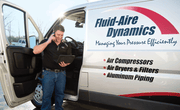How do you fix a noisy air compressor? Industrial air compressors can produce a lot of noise, but there are ways to quiet the din. Sound insulation, sound absorption, vibration dampening, and general maintenance can make a big difference in actual or perceived noise levels from the compressor. Here are ten tips for muffling a loud air compressor and creating a quieter, more pleasant workplace. And for your air compressor repairs and troubleshooting, call us today!

1. Choose a Quieter Compressor Model
Noise levels for an air compressor can vary quite a bit between models. Typical rotary screw air compressors for sale typically operate within a range of 70-75 dB — equivalent to standing next to a busy highway. A reciprocating air compressor may generate noise levels of up to 85 decibels (dB). At this level, you have to raise your voice to be heard, and noise is considered to be a serious nuisance. So, the first thing you can do to lower the volume in the compressor room is to choose a quieter model. If that’s not practical due to your air needs — or it’s simply too late — don’t worry. There are plenty of ways to quiet your existing compressor.

2. Relocate the Air Compressor Away from Workspaces
The first step is to consider placement for your air compressor. Locating your compressor in a dedicated room or a distant corner, away from areas where people are working, will go a long way towards reducing noise levels. Alternatively, you may be able to place your compressor outside. If you go this route, make sure your compressor is properly weatherized for your climate conditions. The more distance you can place between your compressor and the areas where people are working, the less bothersome the noise will be. Of course, you’ll also have to consider the length of your duct runs when making air compressor placement decisions.
3. Build an Acoustic Barrier for the Air Compressor
Placing your compressor in a closed room or behind a sound-dampening wall will help prevent noise from traveling. Heavy materials such as concrete blocks provide more sound-dampening effects than thin wooden walls. For smaller compressors, you may be able to build an enclosure to muffle the compressor noise instead of providing a dedicated room. Just make sure that there is plenty of air space around the compressor and adequate ventilation to prevent overheating; check your user manual or talk to your manufacturer about ventilation requirements for your compressor model.

4. Insulate the Compressor Room with Sound-Dampening Materials
For even more noise reduction benefits, insulate your compressor room or enclosure with sound-dampening materials. Sound blankets are an easy fix: simply drape them over the compressor enclosure or hang them on the walls in the compressor room. Foamboard or acoustic panels can also be added to the compressor room walls. Be sure to allow for adequate airflow around the compressor. Use fire-resistant materials and make sure they are not in contact with the compressor or other heat-producing machinery.
5. Wrap the Compressor in Sound Dampening Materials
If your compressor is not in an enclosed area, you may be able to wrap sound blankets directly around the compressor itself. Sound blankets can go a long way in absorbing the noise from air compressor pistons or rotors. Make sure that the material is fire retardant and does not block the inlet, exhaust, cords, or hoses.
6. Install an Intake Silencer
A lot of the noise from an air compressor resonates from the air intake, which can create high-frequency pulsating noises. An intake silencer is a muffling device that uses tubes or sound-deadening materials to dampen the sound of inrushing air. They may also act as intake filters.

7. Use a Rubber Mat to Absorb Air Compressor Vibrations
Vibrations are another major contributor to air compressor noise levels. Vibrations caused by the movement of the pistons or rotors can transfer through the floor to other parts of the facility — which means the noise transfers, too. A rubber mat placed under the compressor will absorb vibrations and prevent them from being transferred through the floor. Cork or plastic also provides good shock-absorbing properties. As an alternative, you can also use rubber grommets on the air compressor mount in lieu of a full rubber mat. The rubber grommets or feet work in a similar fashion to the mat, absorbing noise-producing vibrations and preventing them from traveling through the floor.
8. Maintain Proper Lubrication Levels for Quieter Air Compressor Operation
You’re doing this part already — right? Right? A happy air compressor is a quiet(er) air compressor, and that starts with proper lubrication. For oil-flooded compressors (which may be a rotary screw, rotary vane, or piston-style), check the oil level several times a week to make sure it is not running low, and change oil at least once a year or more often, depending on your operating times and conditions. You also need to grease the bearings in your air compressor motor. A well-lubricated compressor will last longer and sound better.

9. Regularly Change Air Filters
When intake filters and inline air filters get loaded, your air compressor has to work harder. And when your motor is working harder, it’s also noisier. Change intake filters when they appear visibly dirty or worn. Inline filters should be changed at least once a year or after 8,000 hours of operations. You can monitor pressure drop (the difference in pressure before and after the filter) to determine when filters are loaded.
10. Tighten Loose Parts to Reduce Air Compressor Noise

Maintenance matters. As your air compressor runs, vibrations can cause things to loosen up over time. Tighten up any loose bolts or screws that cause the unit to rattle, and check your bearings and belts to make sure everything is ship-shape. Reducing excessive rattling will not only lower the volume but will also prevent more costly repairs down the road.
Contact Fluid-Aire Dynamics for Noise Reduction Solutions
Reducing air compressor noise doesn’t just make your shop or plant more pleasant; it also protects your team’s hearing, reduces workplace stress, and helps maintain a more professional, productive environment. Whether you’re selecting a quieter compressor, adding sound insulation, or improving maintenance practices, small changes can make a big difference in noise levels.
Not sure where to start? The experts at Fluid-Aire Dynamics can help you diagnose the causes of compressor noise and recommend practical, effective solutions tailored to your system and facility needs.





